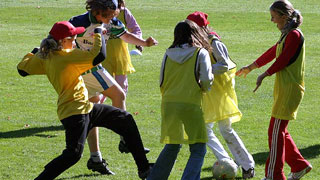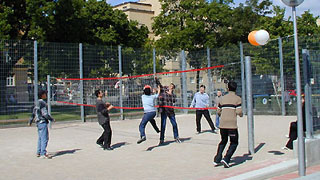From Vienna:
Initial situation

“Children are socialised and have roles allocated to them which are specific to their gender. As a result [many] boys more often turn out in bigger groups, they tend to be noisier and assert their claims and interests more successfully. They take care of their needs [inadvertently at times] at the cost of other park visitors, such as girls, small children and elderly people.
70 percent of girls (and 44 percent of boys) believe it is not wise to try and share spaces already occupied by older boys, thus foregoing any attempts at participation. 82 percent of girls (and 47 percent of boys) who did make relevant attempts were turned away. In the case of girls acts of rejection were often accompanied by sexual insults, as well as threatened or actual sexual aggression.
Solutions
If parks are to be used by girls and boys on equal terms they need to be planned and designed in ways that ensure gender equality. Much depends on additional features such as teams of park supervisors trained in leisure time management and social pedagogics.
What matters most to girls and young women?
- Games and physical activities, such as
- Volleyball, badminton
- Rollerblading
- Climbing, balancing acts, using swings
- Basketball; football in their own safe environment
- Niches for privacy (e.g. pergolas, low walls for seating)
- Safety, such as
- Footpaths must be clearly visible (clear route concept, in direct line of sight to streets and apartment buildings)
- Footpaths across parks must be well lit
- Cleanliness in the park, clean and functioning toilets close to the playground or park if not in the park
What matters most to boys and young men?

- Playing football (cages and open pitches)
- Basketball baskets
- Skater ramps
What matters most to parents/caretakers of small children?
- Separate play areas for small children
- Sufficient numbers of benches and tables with a good view of the play areas
- Places in the shade
- Access to water
- Clean and functioning toilets, close to if not in the park
- Change tables
- Lighting – so that parks can be used after dusk in winter
